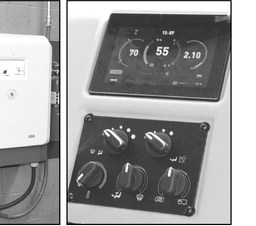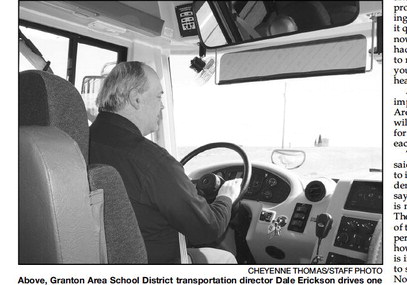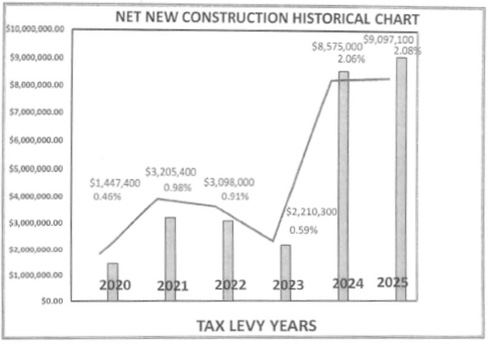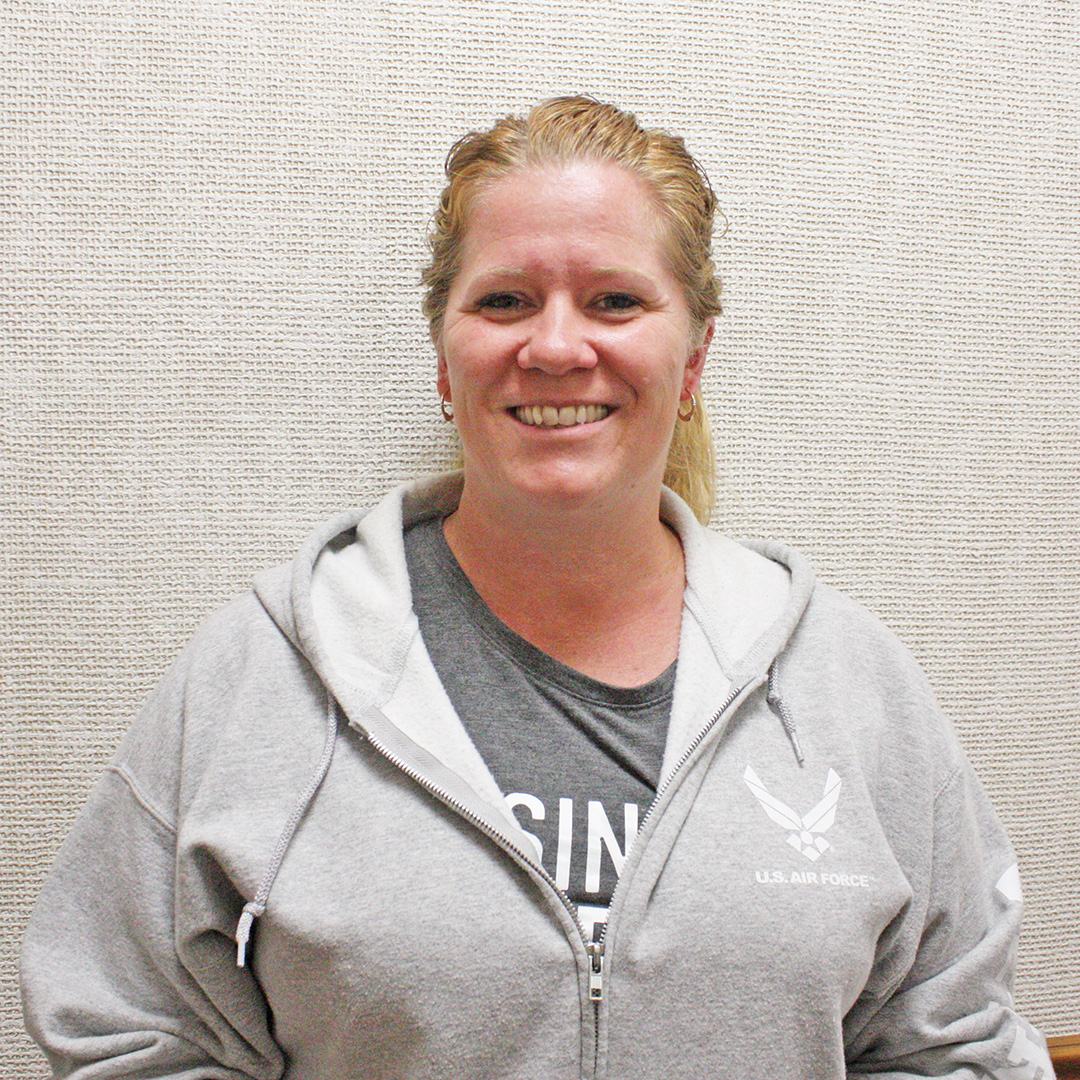Granton School District rolls out new electric buses
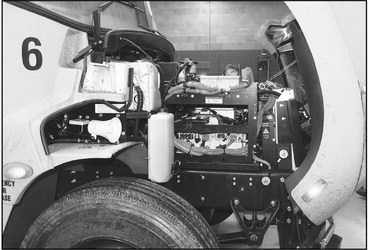

By Cheyenne Thomas As Dale Erickson climbs into the driver’s seat of one of Granton’s new electric buses and turns the engine on, the first thing one will notice is the silence. There’s no roar of an engine coming to life, no sound of rumbling as the engine idles in preparation for a bus route. It’s quiet. So quiet, one can actually hear the students on the bus and their conversations, carry a conversation without raising one’s voice, or listen to the radio without turning it up as loudly as possible to cover the engine’s noise. Erickson said the silence is a good thing.
The silence of the electric bus engine is one of a few subtle differences a person can immediately detect when riding aboard one. The second difference becomes obvious once the bus begins rolling: the sound of music can be heard playing outside the bus as it travels at low speeds. The music stops once the bus reaches 25 miles per hour and when it comes to a complete stop at stop signs, but it’s there as a safety feature to let people know that an electric bus is on the road.
In the past few weeks, the Granton Area School District has begun to put its new electric buses into use. Erickson — who is the district’s transportation director — said that after conducting training with the school’s bus drivers on how to drive the new buses and training with the local fire and EMS crews on how to respond to
Please see Buses, page 25 Buses,
from p. 1
emergencies involving an accident with said buses, the electric buses are now ready to be integrated into Granton’s bus fleet. To start, he said a driver has been using one of the buses to take students to and from Neillsville for sports practices. When that went off without a hitch, the district then switched out one of the diesel buses for an electric one to use on the regular school bus route to pick up and drop off students. With every success, the district has switched out another bus.
“We started doing routes with the electric buses a few weeks ago with the kids we take to Neillsville for practices,” he said. “We started one electric bus on a route two weeks ago and we started another route with an electric bus this past week and will start the third route soon.”
Erickson said Granton has three regular bus routes to pick up and drop off children, with the lightest route having about 40 children and the heaviest route having approximately 55 students. On average, he said the routes are 30 miles; and with the electric buses having a range of about 100 miles, that means the routes can all be completed on one charge — even in the wintertime.
“We got a little experience with winter weather last week (the first week of April) and how the electric buses handle that,” said Erickson. “They can’t really use the regenerative brakes to stop, so range is lowered a bit, not by too much though.”
These ‘regenerative brakes’ are another unique feature of electric buses. In order to drive an electric bus, Erickson said a driver uses a foot pedal that regulates speed. Unlike the gas pedal on a regular vehicle, these pedals don’t allow the vehicle to coast when pressure is taken off. Rather, a braking system is applied when pressure is taken off the pedal, and the energy from braking is transferred back into the bus’s battery.
“Everything is completely controlled by the foot pedal,” he said. “When you let off the pedal, you start to slow down and that breaking method charges the battery. It’s a regenerative braking system that takes the energy and puts it back into the batteries.”
Because of the difference in how the foot pedal works on an electric bus, Erickson said it takes a bit of training to get a driver used to being behind the wheel of an electric bus. But, much like any other vehicle, a driver becomes attuned to how it works the more they use it.
“The biggest thing that comes to mind (as a difference between a diesel and an electric bus) is watching your speed. A lot of drivers drive listening to the sound of the motor to help them regulate their speed. But you don’t have that here. You have to be very conscious of your speed and what you are doing with your foot. But once you get into it, you drive it just like any other vehicle. You learn how to get in tune with the vehicle. Now, when I drive this, I’m at the point where I don’t have to consciously think about where to place my foot and how. I know how to do it instinctually and can regulate my speed between 1 to 2 miles per hour of the speed limit,” he said.
Many of the features on the electric buses are the same as their diesel counterparts. In addition to the acceleration/ deceleration pedal, there is also a regular brake pedal, ignition, lights, wiper blades and other accessories that are found on other buses. The only other notable difference is the addition of a computer panel that tells the driver how many miles they have left on a charge, power consumption and speed.
“The computer system is very good,” said Erickson. “If there is anything wrong, the computer will alert you. One of the things I tell people is to not to be scared of the technology. The biggest misconception is the risk of fire. There are systems that are built into the vehicle to mitigate the risk. It will not let the batteries overheat. This is more of a risk during summertime when the temperatures are hot, but we don’t operate during those peak summer temperatures so that lowers any risk as well.”
Besides being more environmentally friendly, Erickson said there are several other benefits to using an electric bus. Differences between the engines in diesel buses versus electric ones means no oil changes are needed. Maintenance overall is simpler as there are less components that need to be regularly changed.
“You still have brake fluid, brakes and ties that need to be changed,” he said. “The coolant levels are also very important, but that is pretty much it. We don’t have to do oil changes, and if there are any other concerns, the computer will let us know.”
The other benefit Erickson sees with electric buses is the silence. Since the engine is so quiet, he said the drivers are able to hear the students a lot better than they could on a diesel bus, something which makes maintaining discipline on board much easier.
“The drivers noticed right away that they can hear student conversations and that makes it a lot easier to discipline and stop behaviors before they become a problem,” he said. “If things are not going well for a student, you can pick up on it quicker and put a stop to it right away now that you can hear them. Before, you had to rely on being able to see something to realize that there was a problem. Now you don’t have to see something, you can hear something.”
As the electric buses continue to be implemented and used at the Granton Area School District, Erickson said there will continue to be an adjustment period for both the drivers and the students as each group gets used to the new vehicles.
“We’re still in the adjustment phase,” he said. “The students are still getting used to it, we’re still getting used to it. The students have commented to the drivers a lot saying that it’s so quiet on the bus. Silence is not something they’re used to having. The drivers have had to adjust too. Some of them are a little cautious based on their personality, but they are all willing to learn how to drive the buses and that is what is important. The goal is to get everyone to school and back home safe every day. Now, we have another tool to use for that purpose.”
Looking ahead to what the future might hold, Erickson said that it will take some time for electric buses to really gain a foothold in areas like Clark County, but that what they have right now in Granton is a start.
“I think it will be a lot like anything new,” he said. “It gets pushed at the beginning for everyone to get it, and then there will be a slow-down period as the relevant infrastructure have to be built to catch up with demand. The charging infrastructure is what needs to come next and it’s a balancing act. Companies won’t build unless there is demand, but people won’t buy electric vehicles if there is nowhere for them to charge. There are incentives that are being put in place to help drive construction of charging stations. There is money out there to help people with the up-front costs of chargers.”
The Granton School District has five electric buses that will be replacing diesel units on its bus fleet. The district also has two diesel buses that it will keep on its fleet that will be used to longer field trips.
CHEYENNE THOMAS/STAFF PHOTOS
CHEYENNE THOMAS/STAFF PHOTO
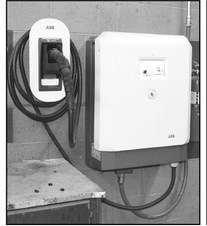
Above, Granton Area School District transportation director Dale Erickson drives one of the school’s new buses.
